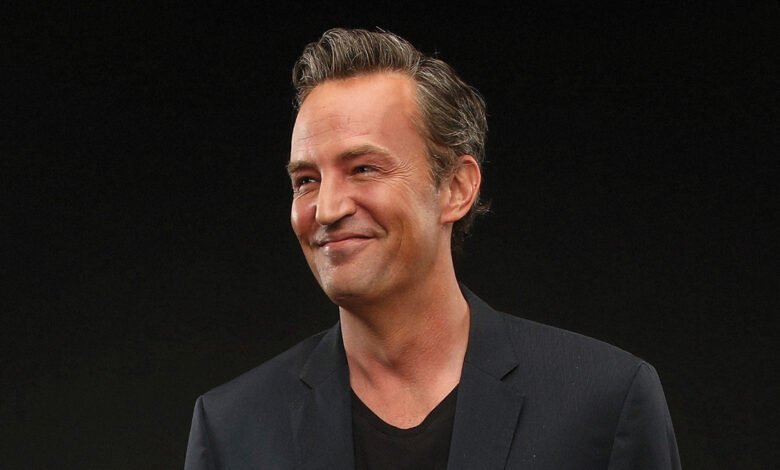A Friend in Need: Why Matthew Perry Couldn’t Make It

Aat one point in Matthew Perry’s memoir, Friends, Lovers, and the Big Terrible Thing, there’s a story about his 2021 stay at a swanky five-star rehab facility in Switzerland, where he was housed in a villa with a breathtaking view of Lake Geneva and assigned a personal butler and gourmet chef. “The kind of luxurious place where you were guaranteed to not meet anybody else,” is how he described the super-private treatment center.
It was hardly the actor’s first attempt at recovery. Before landing in the Alps, he’d been in and out of some 15 different high-end programs for issues with alcohol and prescription drug abuse. There was the luxe detox compound in Malibu where he spent a month in 2001; the therapeutic “trauma camp” in Florida he visited sometime after 2004; the rustic lodge in Sun Valley, Utah, where, in 2011, he practiced yoga and engaged in equine therapy and occasionally encountered a moose strolling the grounds (“No, really, there were moose there; I wasn’t hallucinating”).
By some estimates, Perry spent about $9 million on rehab treatments over the years, not including the $350,000 he dropped on the private jet he hired to shuttle him to and from the facility in Switzerland. But the Lake Geneva program was different. It introduced Perry to a new, experimental form of addiction-recovery therapy that promised remarkable results. Every day, German-speaking nurses would usher him into a darkened room, sit him down for an hour, blindfold him, put headphones over his ears and inject into his arm an IV drip filled with a supposed miracle cure.
“As I lay there in the pitch-dark, listening to Bon Iver, I would disassociate, see things,” Perry wrote of the experience in that 2022 memoir. “I’d been in therapy for so long that I wasn’t even freaked-out by this. Oh, there’s a horse over there? Fine — might as well be.” Before long, the disassociation turned inward, until his very existence in time and space seemed to blur into a haze. “It all became about ego, and the death of ego,” he went on. “I often thought that I was dying during that hour. Oh, I thought, this is what happens when you die.”
The infusion treatment he was receiving in that room in Switzerland turned out to be ketamine, the very narcotic that in October would end up killing him.
Today, Perry’s death remains something of a mystery. Not the specific events that led up to it; those have been thoroughly investigated by a multi-agency criminal task force led by the Los Angeles Police Department. We know, for instance, that after Perry’s first doses in Switzerland, he continued receiving infusions once he returned to L.A., visiting some of the ketamine clinics that had sprung up following promising studies suggesting that the powerful hallucinogenic could be effective in treating depression and anxiety as well as addiction.
We know that after the L.A. clinics refused his requests to up his dosage, Perry began self-administering the drug at home, without medical supervision. We know that he developed such a veracious appetite for ketamine, he began purchasing vast quantities on the black market, spending upward of $67,000 a month. We know that on Oct. 28, 2023, he took too much of it, passed out in a hot tub at his home in Pacific Palisades and drowned. And we know that five people who helped him procure and use the drug — two shady doctors; an aspiring movie producer turned rehab coach who allegedly moonlighted as a dealer; Perry’s 59-year-old live-in assistant; and a woman known as “The Ketamine Queen,” accused of running a North Hollywood stash house — have been arrested and charged in connection to his overdose.
What we still don’t know, though, what’s almost impossible to fathom, is why it happened.

Perry’s home in Pacific Palisades, where, on Oct. 28, he drowned in a hot tub after injecting ketamine and passing out.
4CRNS, WCP/BACKGRID
You’d think that if anybody possessed the resources and support system necessary to battle addiction, it would be this guy, a beloved 54-year-old superstar with a reported $120 million in the bank. Perry could afford the very best — certainly the most expensive — treatment services in the world. He had money to send himself wherever he needed to go to get whatever sort of therapy was necessary. And there was certainly no shortage of people he might have called on for help, comrades he’d known and worked with for years, who cared about his well-being and would have done just about anything for him. This, after all, was an actor who for a decade shared his life with a tight-knit group of co-stars on one of the most popular shows in TV history — you know, the one called Friends.
As it turned out, however, none of that mattered. On the contrary, Perry’s fame and fortune may well have been his undoing. His celebrity and money drew a crowd of opportunistic enablers — including the five whom the LAPD and the feds arrested after his death — who encouraged his drug habits in ways true friends never should. His infinite resources allowed him unlimited opportunity for excess and insulated him from the consequences of his behaviors, except, unfortunately for him, for the horrific toll the drugs took on his health. He endured emphysema, diabetes, chronic pancreatic fibrosis and coronary artery disease — not to mention a series of abdominal surgeries after his 2018 colon rupture that left him carrying a colostomy bag for nine months. Also, there was the time in 2021, just before shooting the Friends reunion, when his top teeth fell out.
Add to all of the above the unique burdens of a Hollywood career — the demands from agents and network and studio chiefs to deliver on schedules that leave little time for healing — and it’s easy to see why so many experts say being rich and famous is more of a hindrance to sobriety than it is a help. It’s also easy to see why so many Hollywood stars succumb to substance abuse, going back decades. Judy Garland, Elvis Presley, Michael Jackson, Heath Ledger, Amy Winehouse — the casualties are strewn all over the Walk of Fame. Indeed, when it comes to treating the disease of addiction, celebrity could almost be considered a co-morbidity.
But what was especially shocking about Perry’s death — and particularly tragic — is that he’d been a poster boy for recovery almost from the day he became famous. As far back as 1999, he was talking about his on-again, off-again “battle to get sober” in his first People magazine cover story (headlined “Happy, Healthy and Hot!”). In 2009, after getting sober yet again, he was so gung ho on clean living that he turned his home in Malibu into a sobriety center where he devoted himself to the healing of others (until a falling out with his sponsor turned business partner, recovery guru Earl Hightower, shuttered “Perry House” in 2013). Most recently, there was Perry’s victory lap over addiction during his 2022 book tour, when he certainly sounded like the clear-eyed survivor of a long, arduous inner battle. “Reality is an acquired taste, and I have spent a great deal of time and had a great deal of problems acquiring it,” he told Bill Maher while plugging his memoir, adding that he now, at long last, felt “safe in my sobriety.”

In a 2002 People magazine cover story, Perry discussed his already long battle with addiction.
Courtesy
In truth, though, he was still very much in danger, already sliding back into destructive old patterns. He kept it well-concealed from most of the outside world — in fact, in the medical examiner’s report after his death, one of Perry’s friends is quoted as saying Perry had been sober “for 19 months” — but in the end, he spent his final days isolated from the people who cared about him most, fanning the flames of his emphysema with a two-pack-a-day cigarette habit, shoveling his new hard-earned Friends residual-streaming dollars from Netflix into the bottomless pockets of crooked doctors and shooting himself up with six to eight hypos of ketamine a day.
***
“If Matthew Perry had been a plumber, he might have had a better outcome,” says Joe Schrank, a well-known addiction expert who has served as a sober counselor to dozens of major Hollywood stars. “I’ll give you an analogy that people in L.A. can relate to — sometimes a movie can be better with a smaller budget. While Perry had all the resources in the world, it wasn’t really working for his best health. Money and connections can buy you better outcomes when it comes to a lot of diseases, but not when it comes to addiction.”
To be sure, many of the high-end rehab facilities where Perry sought help — and where service is always out of network and a month’s stay can cost $150,000 or more — are staffed with good-intentioned professionals who work hard to heal their patients. But they are profit-driven businesses, extremely lucrative ones. So lucrative, private equity companies are starting to regard the rehab sector as a savvy investment opportunity, with some market analysts predicting that the for-profit recovery industry will double in size by the end of the decade, from $6 billion a year to nearly $12 billion. Other estimates put the overall rehab marketplace at a much bigger number, more like $40 billion or $50 billion a year.
Obviously, that kind of money isn’t made purely from good intentions. A 2021 study conducted by a Yale health policy professor found that many for-profit programs “charged inflated fees and used misleading sales practices” and had little success in treating addiction. That study was looking at rehabs that charged in the range of $20,000 a month, not the sorts with views of Swiss lakes or free-range moose — but still, the experience can be hit and miss even at the higher end, especially for celebrities.
“I know rehabs that call the paparazzi to tell them about famous clients, just for the publicity,” says former child star Brandon Cruz (he played Eddie in the 1969-72 comedy The Courtship of Eddie’s Father). As a grown-up, Cruz went through his own recovery and now works as a “surf therapist” in Malibu. “Addiction is already a stigmatized thing,” he goes on, “but when you have rehabs calling paparazzi, disrespecting their patients’ anonymity, it’s sad. People end up getting driven out of programs because of their fame.”
“There are good places and there are bad places,” agrees Richard Taite, the former owner of Cliffside Malibu who now runs an even more luxe program in Beverly Hills, Carrara Treatment Wellness and Spa, catering to ultra-high-net-worth clients (the monthly fee is $165,000). “A bad place will leak the name of a celebrity client because they get a financial benefit to doing so,” he says, explaining the fame-exploiting business model of some for-profit rehab facilities. “They’ll say, ‘This is where Ben went, this is where Lindsay went,’ and then everyone from Middle America that has a problem wants to come out here.”

Promises Malibu, where Perry spent time in 2000, during season seven of the hit show. After shooting the scene where Chandler and Monica get married, he was whisked away to the luxe rehab center in a crewmember’s pickup truck.
Courtesy
Many programs claim to take extraordinary precautions to protect their famous patients’ privacy, and undoubtedly some do. Still, often enough celebrities find themselves outed almost as soon as they arrive. Armie Hammer didn’t make it a week at rehab before a fellow patient leaked his statements at a group therapy session to a tabloid. He was almost out the door when a counselor convinced him to stay. It’s yet another reason recovery can be more challenging for Hollywood stars than for plumbers.
“In L.A., you walk into some rehab meetings and it’s like being at the Grammys or Oscars, chock-full of celebrities,” says Cruz. “People call stars by their stage names, and the stars get pissed off. We had a super-famous guy in one group, and a stalker walked up to him to stroke his hair. The guy never came back to another meeting.”
But even for those who do stick it out for the full 28 days, there’s some question about the efficacy of these programs, including the ultra-swanky ones — in fact, especially those. There is no standard treatment for substance abuse, no one proven method to heal a compulsive psyche. But neither is there a lot of evidence to suggest that addiction can be tamed by infinity pools, gourmet meals and hot-stone massages. Or, for that matter, hanging out with equines, engaging in water play with aquatic mammals or any of the other cheery sounding activities offered to celebrities and other well-heeled patients at some of the recovery resorts.
“There was one place in Orange County where you pet a wolf,” says Schrank. “And there was another with spinner dolphin therapy. Is there any scholarly, peer-reviewed research on how spinner dolphins help people with addictions? You pet them or pray to them — I don’t know what the fuck you do. They say it’s a spiritual experience. But the idea that you could present this as a treatment for a malady as complex as addiction is ridiculous.”
There is, of course, another approach to recovery, one that’s been around for years and involves far less pampering. Robert Downey Jr. struggled with addiction most of his life, went through rehab twice and prison once, but it wasn’t until a stay at CRI-Help that he finally turned things around. The North Hollywood not-for-profit recovery program had the actor sweeping floors and cleaning bathrooms for a year back in the early 2000s. He’s been sober ever since (and, in fact, continues to this day to hold morning sobriety meetings with other Hollywood stars in recovery).
“Robert Downey Jr. got sent to a grimy rehab in the Valley, and that’s what did it for him. It was the right time for him and the right place,” says Schrank. “But there must be something between ‘I pet horses in Malibu’ and scrubbing toilets. Because many people don’t recover in those places, either. It’s not about how indulgently or poorly we treat people. It’s about owning it and respecting it. It’s about people doing the work [of recovery] for themselves. It’s like having a personal trainer — they can’t lift the shit for you.”
The reason Downey spent a whole year at CRI-Help was because in 2001 a court ordered him to — perhaps the luckiest break of his life. Perry, by contrast, seldom spent more than a month at any of the 15 rehab programs he’d checked in to over the course of his life (though he did claim to have undergone 64 detoxes and attended more than 6,000 AA meetings, which probably adds up to something close to a year).
There’s no consensus on what the optimum stay at rehab should be, but there is widespread agreement that the typical 28-day stay isn’t enough. Still, for better or worse, that’s the recovery industry standard and, besides, most working actors don’t feel they can afford to disappear from their careers for much longer than that. They’re probably right. If Perry had approached NBC during an early season of Friends and insisted on a year break to detox, Chandler Bing might well have been written off the show.
We’ve come a long way in addiction awareness since the 1990s, when Perry was popping some 55 Vicodin a day while shooting on the Central Perk set every week — and certainly since the 1940s, when Louis B. Mayer kept MGM’s cameras rolling by shaking bottles of barbiturates down Garland’s throat — but it’s still the same old Hollywood. Agents still want their clients to work, networks still want their actors to show up every day, and film studios still would rather recast than postpone production for a year while waiting for a star to get clean.
In other words, sober or not, the show must go on.

Fans left flowers and other tributes to Perry outside the Friends apartment building in the West Village after his death.
MEGA/GC Images/Getty Images
***
By most accounts, the six young actors who co-starred on Friends did indeed become real-life friends. By the end of the series, they’d been bonded by their shared experience at the center of a decade-long, zeitgeist-defining cultural phenomenon. They are said to have remained close ever since. Indeed, one of the last text messages Perry was known to have sent before his death was to Jennifer Aniston (something about pickleball).
In many ways, the Friends cast was the closest Perry ever came to a family. His parents split when he was 9 months old. His mother, Suzanne Perry, was a former beauty queen who took her young son to Canada, where she found a career as press secretary to Prime Minister Pierre Trudeau. His father, John Bennett Perry, was an actor and model who was largely a non-figure through Matthew’s childhood. “He worked pretty steadily and would become the Old Spice guy,” Perry wrote in his memoir. “I saw his face more often on TV or in magazines than I did in reality.” (Years later, Perry and his dad would become closer; in fact, it was his father who convinced Friends producers Marta Kauffman and David Crane to allow Perry to check into Promises Malibu in 2001 for 90 days, even while he was shooting his famous wedding scene with Courteney Cox. One of the show’s technicians shuttled Perry in his pickup truck back and forth from the set to the rehab facility so he could complete the sequence).

Perry’s best-selling 2022 memoir.
Courtesy of Macmillan
Perry did forge some intense connections in the recovery community — though none of those friendships ended up sticking. Hightower, for one, was Perry’s AA sponsor before they went into business together to open Perry House and then fell apart over money, a debacle Perry blamed for yet another relapse. “I ignored the fact that he was sort of famous in the rehab world, a world in which everything should be anonymous,” Perry writes dismissively of him. And there was Morgan Moses — identified as “Erin” in his book — a sober companion whom he credited with having “saved my life at the rehab when my insides exploded.” They remained close friends for seven years, until, in 2022, less than two years before his overdose, she confronted him about his renewed substance abuse. Perry grew so irate he allegedly physically assaulted her. The two never spoke again.
Instead, tragically, in the final days of his life, Perry surrounded himself with a support group that didn’t look anything remotely like friends.
Let’s start with two of his doctors, Mark Chavez and Salvador Plasencia (or Dr. P, as his patients called him), both of whom have been charged in connection to Perry’s overdose (Chavez has pleaded guilty, Plasencia not guilty). How Perry hooked up with them is unclear — court documents do not spell it out — but we do know that Chavez worked at a ketamine treatment center in San Diego, where he is accused of purloining the vials that ended up being illegally sold to Perry. We know that Chavez and Dr. P, who ran his office in a strip mall in Calabasas, had been associates for 15 years (in an Instagram post, Chavez, 54, referred to himself as 42-year-old Plasencia’s “coach and mentor”). And we know from court filings that the two physicians looked at Perry less as a patient in need of help and more as a mark ready for the plucking.

Dr. Mark Chavez, one of the allegedly shady physicians who sold Perry $55,000 worth of ketamine in October, was arraigned in late August.
Michael Blackshire/Los Angeles Times/Getty Images
“I wonder how much this moron will pay,” Plasencia allegedly texted Chavez at one point, presumably referring to Perry. “Let’s find out.”
The answer turned out to be $55,000, which Perry forked over in cash and electronic transfers to the doctors over the weeks before his death.

So-called Ketamine Queen Jasveen Sangha, who allegedly supplied the drugs.
Jojo Korsh/BFA.com
Perry had other ketamine connections, as well. Through his friend Brooke Mueller — Charlie Sheen’s ex-wife, whom Perry met during one of his rehab stays — he’d been introduced to a 54-year-old former B-movie director-producer named Erik Fleming. After Fleming’s middling film career fizzled (he made 1995’s Cyber Bandits and co-produced the 1999 comedy Bad Trip), he started working at a Bel Air treatment center called the Red Door, but court documents allege Fleming also had a side gig of illegally peddling ketamine to well-off clients. In October, Fleming allegedly sold Perry some $12,000 worth of the drug, which he procured from a stash house in North Hollywood run by a 41-year-old woman named Jasveen Sangha, the aforementioned Ketamine Queen, a flamboyant, well-connected figure (whom, as it happens, Mueller knew from rehab). Fleming has been charged with distributing ketamine resulting in a death (he’s pleaded guilty), while Sangha has been charged with distribution of ketamine and maintaining a drug-involved premises, among other crimes (she has pleaded not guilty).
But perhaps the closest person in Perry’s life in the final months was Kenneth Iwamasa, his 59-year-old live-in assistant, whom Perry had taken to calling “Alfred,” as in Batman’s butler.
Iwamasa had been in Perry’s orbit for a while, formerly working for the actor’s manager, Doug Chapin, but had only recently moved into Perry’s house to become his personal assistant. There’s been some debate in tight-knit Hollywood assistant circles over whether Iwamasa is a sympathetic figure or not. Some say he should have left the job when he realized what his duties would entail, others say he had no choice, that assistants never do. But according to court documents, it was Iwamasa who gave Perry the ketamine injection that resulted in his death (“Make it a big one,” his boss had instructed him). He’s the one who later that day, after running errands, returned to Perry’s Pacific Palisades home and discovered his body floating in the hot tub. He’s the one who tried (and failed) to pull him out of the water. And he’s the one who, idiotically, ran through the house collecting and hiding evidence of drug use.
Iwamasa has been charged with one count of conspiracy to distribute ketamine causing death (he’s pleaded guilty).

Perry with Kenneth Iwamasa, his 59-year-old live-in personal assistant who administered the actor’s final dose of ketamine.
BACKGRID
“It was toxic,” says Schrank of the motley crew Perry cast around him at the end. “But that’s what they do. Addicts like Perry are going to surround themselves with enablers — assistants who will not draw lines in the sand, sycophantic hangers-on who’ll do anything to be near a celebrity, including get them drugs — and distance themselves from people that will tell them hard truths.”
One of those hard truths, sadly, is that for some people — especially those unlucky enough to be as rich and handsome and famous as Matthew Perry — there sometimes is no help. At the end of his own long, tortured and ultimately doomed recovery journey, that’s the grim conclusion Perry himself appears to have come to.
“Take it from me,” he wrote in his memoir, summing up his experience with celebrity rehab over many long, painful decades. “I’m an expert. I’ve poured millions of dollars into this ‘system.’ Did the money help me, or hurt me? There’s no way I could run out of money doing drugs or alcohol. Does that make it harder? I’m glad we’ll never know.”
This story appeared in the Sept. 19 issue of The Hollywood Reporter magazine. Click here to subscribe.




